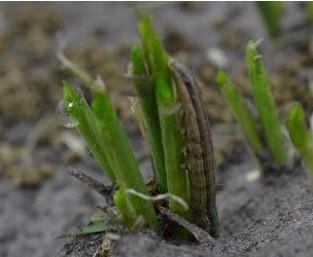By Bruce Potter
Several additional reports of true armyworm infestations have come in from a wide area in southern and into west central Minnesota. There are likely fields in other geographies that saw armyworm moth immigrations, as well.

True armyworm. Photo: Bruce Potter
Migration patterns
Migrating armyworm moths have been moving into Minnesota since early May. Based on the descriptions of larval size and moth captures, the infestations being reported are likely related to moths arriving with a series of storms about three weeks ago (true-armyworm blacklight captures).
These were not extremely large flights compared to those during other outbreak years but were evidently large enough to create some problems. Since then, subsequent southerly winds continue to bring armyworm moths into Minnesota as far north as Roseau County. This means that armyworm infestations might continue to show up for a while. Any moths from these flights would have sought out and laid eggs in stands of dense grasses such as cereals, weedy grasses, roadsides, pastures, and hay ground.
Dense grasses attract moths
Most of the current reports have been from corn planted into a rye cover crop but other grass crops can also be affected. True armyworms prefer to feed on grasses but, sometimes after rye or dense stands of grass weeds are killed, soybeans can be defoliated by starving armyworms.
Rye covers are likely to differ in risk of armyworm infestation. Areas of dense, lush rye would be most attractive to moths. Rye that was killed before the moths arrived would not provide attractive egg-laying sites. Check areas of dense, late-terminated rye and lodged areas in small grains and other grasses first.
Larval development
Armyworm larvae are most active at night and other low-light periods. The larval stage lasts 20-30 days depending on temperature and the mature larvae are 1 ¼ to 1 ½- inches long. Most vegetation is consumed during the last two instars and as a result, infestations often go unnoticed until it’s too late.
Warm temperatures speed larval development. The presence of feeding injury to crops and frass means armyworms were there. Make sure armyworms are still present before you spray. A sweep net is a useful tool when scouting for the presence of small larvae. In corn, armyworms larvae may hide in the whorl or on the ground. In small grain or grass fields, vigorously shake the plants in several areas to dislodge larvae so they can be counted on the ground. Be sure to check under any dirt clods and plant residue.
Economic thresholds and treatment
Economic thresholds for whorl-stage corn are 25% of the plants with two or more larvae/plant or 75% of the plants with one larva or more. For small grain and grass hay crops treat when there are 4 to 5 larvae/square foot.
You may not need to treat the whole field if armyworm infestations are limited to a portion of the field, but treat at least a swath or two ahead of the infestation. Depending on the crop, several pyrethroids are labeled for true armyworm control. In recent years, there have been some scattered reports of poor performance with pyrethroid insecticides on armyworms, but these are not necessarily due to insecticide resistance. Insecticides may not perform as well when applied under hot conditions and coverage is important.
Depending on the crop, chlorantraniliprole, methoxyfenozide, spinosad, spinetoram, indoxacarb, carbaryl, and methomyl are also labeled for armyworm control. One site with a comprehensive list of insecticides labeled for control of armyworm is the 2022 NDSU Insect Management Guide.
Small larvae are usually the easiest to control. Note that some of the labeled insecticides are only effective on small larvae. Read the label carefully for application rates, timing, re-entry interval and pre-harvest interval, herbicide interactions, and other restrictions. Always remember to evaluate the performance of your insecticide treatment.
Source : umn.edu